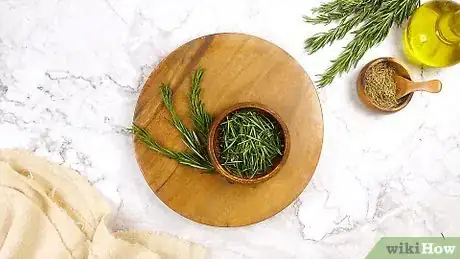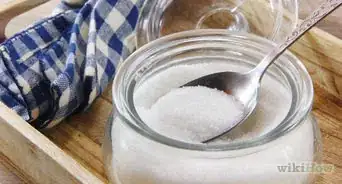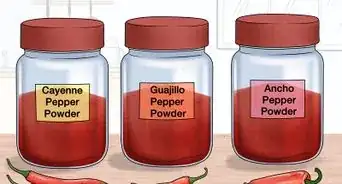This article was co-authored by Lorena Barcal. Lorena Barcal is a Clinical Herbalist, Clean Beauty Specialist, and Writer for IslandBeauty.co, a blog dedicated to sharing the benefits of using all-natural beauty products and recipes created by herbalists. Lorena specializes in studying and developing natural alternatives for beauty products. After finishing her herbal studies, Lorena managed an herbal lab in Barcelona developing natural beauty products. As a writer for IslandBeauty.co, she shares knowledge and insights to promote the natural beauty industry.
There are 12 references cited in this article, which can be found at the bottom of the page.
wikiHow marks an article as reader-approved once it receives enough positive feedback. This article received 16 testimonials and 99% of readers who voted found it helpful, earning it our reader-approved status.
This article has been viewed 631,434 times.
Rosemary oil is a popular infused oil used in cooking and beauty treatments. If you want to make rosemary oil quickly, heat a few sprigs of fresh rosemary in your oil of choice. However, keep in mind that this oil must be used within a week or it could go rancid. Alternatively, use dried rosemary to create an oil with a longer shelf life. Dried rosemary can be mixed with your oil of choice in a canning jar and set in a sunny place to slowly infuse into an edible oil. This method can be used with prepackaged dried rosemary or your own homemade dried rosemary.
Ingredients
Fresh Rosemary Oil
- Three or four sprigs of fresh rosemary
- Two cups (475 ml) of oil (olive oil, jojoba oil, or sweet almond oil)
Dried Rosemary Oil
- Three or four sprigs of dried rosemary OR
- One large tablespoon of dried rosemary
- About two cups (475 ml) of olive oil
Steps
Using Fresh Rosemary
-
1Wash and measure the rosemary. Wash a few sprigs of fresh rosemary under cold, running water to remove any dirt and debris. Next, remove the leaves from the stem and measure out about a cup of leaves.[1]
- Leftover rosemary leaves can be discarded or set aside for other recipes.
-
2Fill a small saucepan with oil. Measure out two cups of oil and pour them into a small saucepan. Most people prefer to use olive oil for its flavor, cooking uses, and cosmetic applications. However, if you’re planning on exclusively using your oil for beauty purposes, you can use jojoba oil or sweet almond oil.[2] [3]
- Jojoba oil and sweet almond oil should not be eaten or used in cooking.
Advertisement -
3Heat the rosemary in the oil. Add the rosemary sprigs to the saucepan. Place the pan over low heat on your stove. Heat the rosemary for five to ten minutes, stirring constantly.[4] As the oil warms up, it will begin to smell like rosemary.
- If the oil begins bubbling around the rosemary, the oil is too hot. Reduce the heat and stir.
-
4Strain and cool the oil. Place a metal colander in a large metal bowl. Pour the oil mixture into the colander to strain out the rosemary pieces. Discard the leftover pieces of rosemary and let the oil cool in the bowl. [5]
- Metal strainers and cheesecloths can also be used to strain the oil. Make sure the oil has cooled before using these tools.
-
5Bottle the oil. Once the oil has cooled to room temperature, it can be poured into a clean bottle. Label the bottle with the bottling date and the ingredients used. However, resist the urge to add a sprig of rosemary to the bottle. It looks pretty, but it can cause harmful bacteria to grow in the oil.[6]
-
6Refrigerate the oil. Oils infused with fresh herbs should be refrigerated and used within the week.[7] This will prevent the growth of any harmful bacteria that could cause the oil to become rancid.
- If the oil is a gift, be sure to include a “use by” date on the label.
Infusing Oil with Dried Rosemary
-
1Sanitize a canning jar. Fill a large, deep pot with water and place it over medium-high heat. Once the water comes to a boil, use tongs to place the canning jar in the water. Let the jar boil for ten minutes to kill any harmful bacteria that may ruin your rosemary oil.
- You don’t need to boil the lid. Instead, wash the lid with soap and water and let it air dry.[8]
- You can also use a boiling-water canner to sterilize the canning jar. If so, follow the manufacturer instructions.
-
2Put dried rosemary in the jar. If you dried your own rosemary, place three to four sprigs in the jar. If you’re using prepackaged dried rosemary, add a large tablespoon to the canning jar.[9]
- Do not use fresh, undried rosemary. If you do, your oil will become rancid and might grow harmful Botulism bacteria.[10]
-
3Pour oil over the rosemary. Fill the jar with olive oil, leaving about half an inch (1.2 centimeters) of space at the top. Make sure all of the rosemary is completely submerged in the oil.[11] If necessary, use a clean spoon to push dried rosemary into the oil.
- You could also use coconut oil in place of olive oil.[12]
-
4Set the jar in the sun. Screw the lid onto the canning jar and set it in a sunny place. Let it sit undisturbed for two weeks.[13] During this time, the oil will slowly heat and become infused with rich rosemary flavors. After two weeks, you can use your rosemary oil.
-
5Strain the oil. Place a cheesecloth in a large metal bowl. The edges of the cheesecloth should hang over the sides of the bowl. Next, pour the contents of the canning jar into the cheesecloth. Gather the cheesecloth into a bundle and squeeze it over the bowl to separate the oil from the small dried rosemary pieces.[14]
- Use clean hands to squeeze the cheesecloth.
- Discard the leftover pieces of rosemary.
-
6Store the rosemary in your pantry. Pour the strained olive oil back into the canning jar and replace the lid. If you want, add a sprig of dried rosemary to the oil for decoration. Oils infused with dried herbs have a shelf life of one year. [15]
- If you move the oil to a new jar, sterilize the jar first.
Drying Fresh Rosemary
-
1Wash fresh rosemary. Fresh rosemary can be harvested from your own rosemary bush or purchased at the grocery store. Wash the sprigs of fresh rosemary under running water to remove dirt and debris. Pat the rosemary with a paper towel to remove excess water or use a salad spinner.
- You will need three to four sprigs of rosemary to make one canning jar’s worth of rosemary oil.
- Dried rosemary has a very long shelf life. Dry as much as you want, even if you don’t plan on using it all for rosemary oil.
-
2Place the rosemary on a baking sheet. Line a large baking sheet with a large piece of parchment paper. Next, place the rosemary on the baking sheet in a single layer. If you overcrowd the rosemary, it won’t dry properly in the oven.
-
3Dry the fresh rosemary in the oven. Preheat your oven on the lowest setting for ten minutes. Next, place the baking sheet of rosemary in the oven. Let the rosemary bake for two to four hours.
- When the rosemary is done drying, it will crumble easily between your fingers.
- Let the sprigs cool completely before making rosemary oil.
Expert Q&A
-
QuestionWhat is best carrier oil for rosemary oil?
 Lorena BarcalLorena Barcal is a Clinical Herbalist, Clean Beauty Specialist, and Writer for IslandBeauty.co, a blog dedicated to sharing the benefits of using all-natural beauty products and recipes created by herbalists. Lorena specializes in studying and developing natural alternatives for beauty products. After finishing her herbal studies, Lorena managed an herbal lab in Barcelona developing natural beauty products. As a writer for IslandBeauty.co, she shares knowledge and insights to promote the natural beauty industry.
Lorena BarcalLorena Barcal is a Clinical Herbalist, Clean Beauty Specialist, and Writer for IslandBeauty.co, a blog dedicated to sharing the benefits of using all-natural beauty products and recipes created by herbalists. Lorena specializes in studying and developing natural alternatives for beauty products. After finishing her herbal studies, Lorena managed an herbal lab in Barcelona developing natural beauty products. As a writer for IslandBeauty.co, she shares knowledge and insights to promote the natural beauty industry.
Clinical Herbalist & Clean Beauty Specialist Jojoba and coconut oils are the best carrier oils to use, as they mix very well and create a great natural beauty product.
Jojoba and coconut oils are the best carrier oils to use, as they mix very well and create a great natural beauty product. -
QuestionDoes this work to put in lotions, soap, shampoo, ect.
 Community AnswerYes. Many people like to put a few drops of rosemary oil in their lotions, soaps, and shampoos before using them. To do so, mix a small amount of product in a small bowl with a few drops of rosemary oil.
Community AnswerYes. Many people like to put a few drops of rosemary oil in their lotions, soaps, and shampoos before using them. To do so, mix a small amount of product in a small bowl with a few drops of rosemary oil. -
QuestionWhat if I cannot get fresh rosemary?
 Community AnswerIt's perfectly fine to use dried rosemary instead. One large tablespoon of crumbled, dried rosemary equals about three to four sprigs of fresh rosemary.
Community AnswerIt's perfectly fine to use dried rosemary instead. One large tablespoon of crumbled, dried rosemary equals about three to four sprigs of fresh rosemary.
References
- ↑ http://www.popsugar.com/smart-living/How-Make-Rosemary-Oil-30941905
- ↑ Lorena Barcal. Clinical Herbalist & Clean Beauty Specialist. Expert Interview. 28 June 2020.
- ↑ http://www.diynatural.com/easy-herbal-oil-infusion/
- ↑ http://www.food.com/recipe/rosemary-infused-oil-113013
- ↑ http://www.teacher-chef.com/2013/07/18/rosemary-infused-olive-oil/
- ↑ http://www.oliveoilsource.com/page/infusing-olive-oil
- ↑ http://preparednessmama.com/herb-infused-oil/
- ↑ http://www.countryliving.com/food-drinks/a5204/new-canning-guidelines/
- ↑ https://www.leaf.tv/articles/how-to-make-rosemary-oil/
- ↑ http://www.oliveoilsource.com/page/infusing-olive-oil
- ↑ http://theseamanmom.com/how-to-make-rosemary-infused-oil/
- ↑ Lorena Barcal. Clinical Herbalist & Clean Beauty Specialist. Expert Interview. 28 June 2020.
- ↑ http://ahealthylifeforme.com/how-to-make-rosemary-essential-oil/
- ↑ https://theherbalacademy.com/herb-infused-oils/
- ↑ https://theherbalacademy.com/herb-infused-oils/
About This Article
To make fresh rosemary oil, start by washing a few sprigs of rosemary under cold water. Then, remove the leaves from the stem and measure out 1 cup of leaves. Next, mix the leaves with 2 cups of olive oil in a saucepan and heat the mixture over low heat for 5-10 minutes. Once the oil smells like rosemary, place a colander in a large metal bowl and strain out the rosemary pieces. Bottle the oil and store it in the refrigerator for up to 1 week. To learn how to infuse oil with dried rosemary, keep reading!




























































